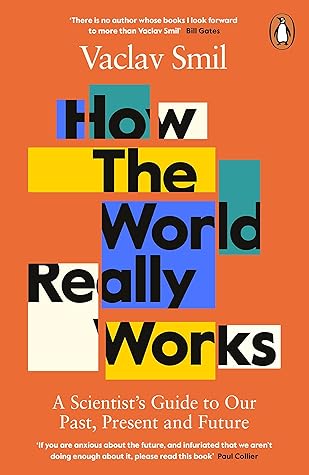More on this book
Community
Kindle Notes & Highlights
Annual global demand for fossil carbon is now just above 10 billion tons a year—a mass nearly five times more than the recent annual harvest of all staple grains feeding humanity, and more than twice the total mass of water drunk annually by the world’s nearly 8 billion inhabitants
Both the high relative share and the scale of our dependence on fossil carbon make any rapid substitutions impossible: this is not a biased personal impression stemming from a poor understanding of the global energy system – but a realistic conclusion based on engineering and economic realities.
modern world’s most important—and fundamentally existential—dependence on fossil fuels is their direct and indirect use in the production of our food.
When sufficiently impressed by the fossil fuel burden of this simple food, you can transfer the plate’s contents to a bowl, add two or three additional tomatoes, some soy sauce, salt, pepper, and sesame seeds, and enjoy a tasty tomato salad. How many vegans enjoying the salad are aware of its substantial fossil fuel pedigree?
Google’s Ngram Viewer charts provide excellent illustrations of long-term trends of attention paid to any notable developments.
between 1971 and 2019 microprocessor power increased by seven orders of magnitude—17.1 billion times,
The history of globalization reveals an undeniable long-term trend toward greater international economic integration that is manifested by intensified flows of energies, materials, people, ideas, and information, and that is enabled by improving technical capabilities.
Questioning and criticizing globalization has gone beyond narrowly ideological arguments, and the COVID-19 pandemic provided additional powerful arguments based on irrefutable concerns about the state’s fundamental role in protecting the lives of its citizens. That role is hard to play when 70 percent of the world’s rubber gloves are made in a single factory, and when similar or even higher shares of not just other pieces of personal protective equipment but also of principal drug components and common medications (antibiotics, antihypertensive drugs) come from a very small number of suppliers
...more
Public reaction to risks is guided more by a dread of what is unfamiliar, unknown, or poorly understood than by any comparative appraisal of actual consequences. When these strong emotional reactions are involved, people focus excessively on the possibility of a dreaded outcome (death by a terrorist attack or by a viral pandemic) rather than trying to keep in mind the probability of such an outcome taking place.100 Terrorists have always exploited this reality, forcing governments to take extraordinarily costly steps to prevent further attacks while repeatedly neglecting to take measures that
...more
during the second decade of the 21st century about 125,000 Americans were killed by guns (the total for homicides, excluding suicides): that is the equivalent of the population of Topeka, Kansas or Athens, Georgia or Simi Valley, California—or of Göttingen in Germany.101 In contrast, 170 Americans died in all terrorist attacks in the US during the second decade of the 21st century,
And while Amazonian trees, as any terrestrial plants, produce O2 during diurnal photosynthesis, they—again, much as any other photosynthesizing organism—consume virtually all of this oxygen during nocturnal respiration, the process that uses photosynthate to produce energy and compounds for plant growth.
We are concerned about too much of something without which we could not be alive: the greenhouse effect.
De omnibus dubitandum (Doubt everything)
Many forecasts are nothing but the simplest extensions of past trajectories;
Moving from relatively simple pencil-and-paper forecasts to complex computerized scenarios makes it easier to perform the requisite calculations and to produce different scenarios, but it does not eliminate the inevitable perils of making assumptions. Just the opposite—more complex models combining the interactions of economic, social, technical, and environmental factors require more assumptions and open the way for greater errors.


